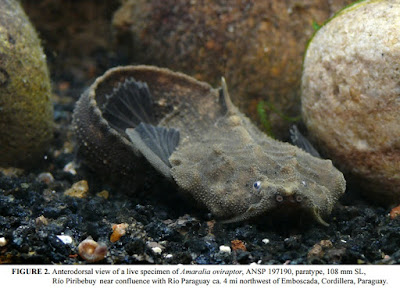 |
| Amaralia oviraptor |
Abstract
A new species of the banjo catfish genus Amaralia is described from the Paraná-Paraguay River Basin in central-western Brazil, Paraguay and northern Argentina. Amaralia oviraptor is distinguished from its single and allopatric congener, Amaralia hypsiura, by the greater number of dorsal-fin rays (3 vs. 2); by the absence of lateral contact between middle and posterior nuchal plates (vs. middle and posterior nuchal plates contacting each other laterally); and by a longer cleithral process (17.4–19.5 % of SL, mean 18.2 % vs. 14.0–17.2 % of SL, mean=15.5 %). Comments on the peculiar oophagic diet of Amaralia and an extended diagnosis of the genus are provided.
Keywords: Pisces, Neotropical, biodiversity, banjo catfish, osteology, oophagy
 |
| FIGURE 1. Amaralia oviraptor, MZUSP 4423, holotype, 68 mm SL Brazil, Mato Grosso, Santo Antônio do Leverger municipality, rio Cuiabá. |
Distribution. Amaralia oviraptor is widely distributed in the Paraná-Paraguay River system, found throughout the Paraguay River Basin in Brazil, Paraguay and northern Argentina and also in the Paraná drainage in Argentina and Brazil (Fig. 8). The new species seems to be absent in some portions of this system such as the Uruguay River Basin and the main tributaries of the upper Paraná.
Etymology. The epithet oviraptor is a combination of the Latin ovum (ovi), meaning egg; and raptor, a robber or plunderer, commonly used term for a predator, here referring to the peculiar dietary preferences observed in this species. Treated as a noun in apposition.
Ecological notes. An interesting aspect of Amaralia is its apparent dietary specialization on both the eggs and developing embryos of other catfishes (Friel, 1994; Roberts, 2015). Direct evidence of such oophagy is based on examination of the stomach contents from 23 preserved Amaralia specimens (17 A. hypsiura and six A. oviraptor ). Seven of these specimens (six female and one male) contained masses of ova or developing embryos in their stomach. The source of the eggs and embryos is most likely those of loricariid catfishes, and in least in one instance, the caudal fin-ray counts of the embryos fall within the range for loricariid catfishes. One male contained a single scoloplacid catfish specimen in its stomach, and the remaining 15 specimens (seven female and eight male) had empty stomachs. These observations differ significantly from the documented diets of other aspredinids, where stomach contents typically contained some organic detritus along with various aquatic and terrestrial insect prey.
John P. Friel and Tiago P. Carvalho. 2016. A New Species of Amaralia Fowler (Siluriformes: Aspredinidae) from the Paraná-Paraguay River Basin. Zootaxa. 4088(4)
Resumo:
Uma nova espécie de Amaralia é descrita da bacia do Paraná-Paraguai no Centro-Oeste do Brasil, Paraguai e Norte da Argentina. Amaralia oviraptor difere-se do seu único congênere de distribuição alopátrica, Amaralia hypsiura, pelo maior número de raios da nadadeira dorsal (3 vs. 2); pela ausência de um contato lateral entre a placa nucal mediana e a placa nucal posterior (vs. placa mediana e posterior contatando uma a outra lateralmente); e por um processo cleitral mais longo (17.4–19.5 % do CP, média = 18.2 % vs. 14.0–17.2 % do CP, média = 15.5 %). Comentários sobre o gênero são feitos acerca de sua dieta oofágica e uma diagnose entre os aspredinídeos é fornecida.
Palavras-chave: Neotropical, biodiversidade, bagre banjo, osteologia, oofagia.

